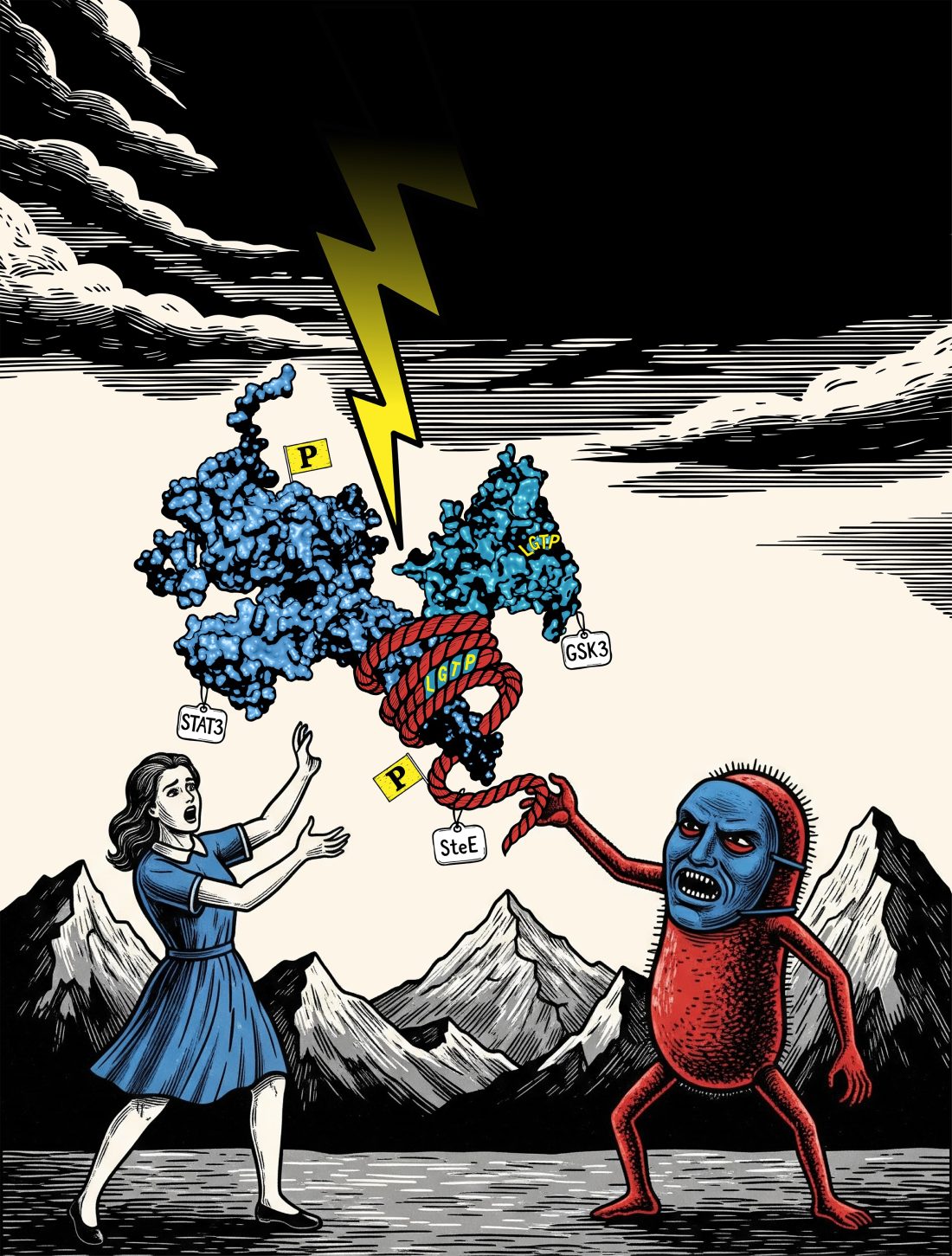Converting a kinase through molecular mimicry
 Kinases carry out phosphorylation, a diverse, reversible post-translational modification that mediates the precise regulation of diverse, core cellular processes, including cell cycle progression, metabolism and immune signalling. Paramount to the integrity of phospho-regulated signalling networks is the strict control of kinase substrate specificity; this refers to both the amino acid that is phosphorylated and the substrate that becomes phosphorylated. Conventional dogma assigns eukaryotic kinases to one of three groups according to the amino acid(s) they phosphorylate; serine/threonine kinases, tyrosine kinases and a rarer group that phosphorylate serine, threonine and tyrosine residues – the so-called dual specificity kinases (DSKs).
Kinases carry out phosphorylation, a diverse, reversible post-translational modification that mediates the precise regulation of diverse, core cellular processes, including cell cycle progression, metabolism and immune signalling. Paramount to the integrity of phospho-regulated signalling networks is the strict control of kinase substrate specificity; this refers to both the amino acid that is phosphorylated and the substrate that becomes phosphorylated. Conventional dogma assigns eukaryotic kinases to one of three groups according to the amino acid(s) they phosphorylate; serine/threonine kinases, tyrosine kinases and a rarer group that phosphorylate serine, threonine and tyrosine residues – the so-called dual specificity kinases (DSKs).
The Thurston group previously identified a novel phenomenon they called kinase reprogramming, whereby the amino acid and substrate specificity of a host kinase, called GSK3, is altered when bound by the small Salmonella virulence protein, SteE. That is, remarkably, when SteE interacts with GSK3, this otherwise strict serine/threonine kinase phosphorylates new substrates on tyrosine residues.
Until now, it was not known whether kinase reprogramming was specific to Salmonella or not. In this new study, led by postdoctoral researcher Ioanna Panagi, the team shows that the reprogramming of GSK3 happens in diverse Gram-negative bacteria, and is mediated by homologues of SteE found in those organisms. As the mechanism behind the switch in GSK3’s activity remained enigmatic, they then investigated the molecular basis of how SteE targets GSK3 in Salmonella. They found that SteE-induced tyrosine activity conferred on GSK3 requires an L/xGxP motif found in SteE. Interestingly, this motif was previously shown to mediate GSK3 autophosphorylation on a tyrosine residue and is found in several kinases that undergo auto-tyrosine phosphorylation. Overall, they propose that a series of short linear motifs within SteE, which each mimic eukaryotic signalling motifs, mediate kinase selection, kinase reprogramming and substrate selection, ultimately driving kinase reprogramming.
Few kinases are true dual-specificity kinases that phosphorylate S/T and Y residues of substrates. This study suggests that kinase reprogramming allows an expansion of the kinome without the need for an entirely new kinase, representing a fourth class of kinases that are adaptable.
The findings of this work were summarised in Artwork that was selected as the Cover Image for EMBO Reports. The image shows, Salmonella, wearing a mask to depict how it mimics the host cell (lady in blue). The bacterium is holding SteE (rope) which acts a link to tie the host kinase GSK3 together with its substrate STAT3.
Cover Artwork concept by Teresa Thurston, Ioanna Panagi and Katrin Rittinger with design work carried out by Bridget Gollan.
Explore more
Read the paper
Panagi I, et al. (2025). Bacterial effectors mediate kinase reprogramming through mimicry of conserved eukaryotic motifs. EMBO Rep. 2025 Jul;26(14):3529-3553. doi: 10.1038/s44319-025-00472-y
Infection and Immunity
Several Dunn School groups use a range of approaches to investigate antigen presentation and immune regulation during health and disease and study the mechanisms that enable bacterial and viral pathogens to invade and proliferate inside their hosts.
More news
The latest news stories and research highlights from the Dunn School.